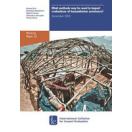
What methods may be used in impact evaluations of humanitarian assistance?
3ie Working Paper 22
Since 2005, more than US$90 billion has been spent on humanitarian assistance. Humanitarian crises are complex situations where demand for aid very often exceeds supply. The humanitarian assistance community has long asked for better evidence on how aid money can be spent more effectively.
This paper by Jyotsna Puri , Anastasia Aladysheva, Vegard Iversen, Yashodhan Ghorpade and Tilman Brück explores the methodological options and challenges associated with collecting and generating high-quality evidence needed to answer important questions on the impact of humanitarian assistance. These questions include whether assistance is reaching the target populations and at the right time, whether it is bringing about desired changes in their lives and whether it is being delivered in effective doses and ways, with manageable costs.
The paper also uses six case studies to discuss methods for undertaking impact evaluations to address these concerns in a range of humanitarian contexts, from unanticipated natural disaster-related emergencies to protracted crises.
This working paper is part of background scoping research and consultation undertaken to assess the scope and methods for impact evaluation in the humanitarian sector. The scoping paper, What evidence is available and what is required, in humanitarian assistance?, provides an independent analysis of the evidence base of evaluations in humanitarian assistance and identifies key gaps and priorities in need of rigorous evidence.




